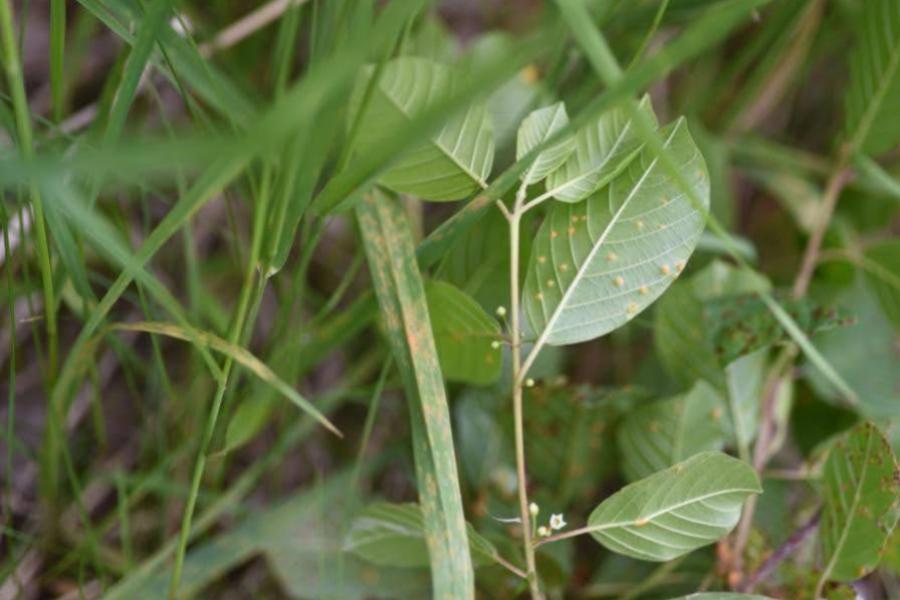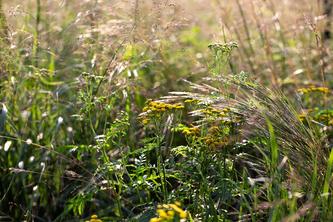
Though some crown rust fungi are known to cause widespread damage to oat and barley crops, new research from the University of Minnesota suggests a close relative of these major pathogens could actually be a valuable asset in managing two highly invasive wetland plants in Minnesota.
Findings recently published in Plant Disease show that Puccinia coronata var. coronata, or Pcc — a non-native rust fungus recently reported in North America — could be beneficial in managing glossy buckthorn (Frangula alnus) and reed canarygrass (Phalaris arundinacea).
“As this fungal pathogen affects two highly invasive species, understanding its host range helps define strategies and predict its impact if used as an augmentative biocontrol agent,” said Pablo D. Olivera Firpo, a research associate professor in the Department of Plant Pathology.
The research was funded by the University’s Minnesota Invasive Terrestrial Plants and Pests Center, supported by the Minnesota Environment and Natural Resources Trust Fund as recommended by the Legislative-Citizen Commission on Minnesota Resources (LCCMR).
To assess the host range — which plants are susceptible to infection — the research team conducted extensive greenhouse trials. Over 1,800 samples of cereal crop species like wheat, oats, barley, and rye; 110 grass species; and 16 species in the ornamental shrub and buckthorn families were evaluated for their response to Pcc.
The researchers found:
- No cereal crops or turfgrasses were found to be susceptible to Pcc.
- In addition to reed canarygrass, 12 other grass species were found susceptible to Pcc — some native to Minnesota or North America, some highly weedy.
- Three native North American buckthorn species were also susceptible to the pathogen.
“It is highly valuable to predict what plants might be affected by a new pathogen and to understand the host ranges of rust fungi more broadly,” said Nick Greatens, a recent U of M doctoral graduate. “Fortunately, no important crops or turfgrasses are affected by Pcc. Locally, the pathogen has apparently positive effects, knocking back some highly weedy plant species. The benefit to an ecosystem will depend on the local plant community.”
Future work will quantify the effects on invasive reed canarygrass and glossy buckthorn in greenhouse experiments. Efforts are ongoing to document the occurrence of various crown rust fungi on buckthorns and wild grasses across Minnesota.
According to previous research, reed canarygrass (Phalaris arundinacea) populations in Minnesota are mostly native, although the plant may form aggressive stands and require control.
About the College of Food, Agricultural and Natural Resource Sciences
The University of Minnesota’s College of Food, Agricultural and Natural Resource Sciences (CFANS) strives to inspire minds, nourish people, and sustainably enhance the natural environment. CFANS has a legacy of innovation, bringing discoveries to life through science and educating the next generation of leaders. Every day, students, faculty, and researchers use science to address the grand challenges of the world today and in the future. CFANS offers an unparalleled expanse of experiential learning opportunities for students and the community, with 12 academic departments, 10 research and outreach centers across the state, the Minnesota Landscape Arboretum, the Bell Museum of Natural History, and dozens of interdisciplinary centers. Learn more at cfans.umn.edu.
About the Minnesota Invasive Terrestrial Plants and Pests Center
The Minnesota Invasive Terrestrial Plants and Pests Center (MITPPC) was founded by the Minnesota Legislature to research the prevention, detection and control of terrestrial invasive species. MITPPC researchers use transformative science to prevent and minimize the threats posed by land-based invasive plants, pathogens, and pests. Founded in 2015, MITPPC is the only research center of its kind in the country, and the center's work to protect the state's native prairies, forests, wetlands, and agricultural resources benefits all of Minnesota and beyond. Learn more at mitppc.umn.edu.
- Categories:
- Agriculture and Environment





